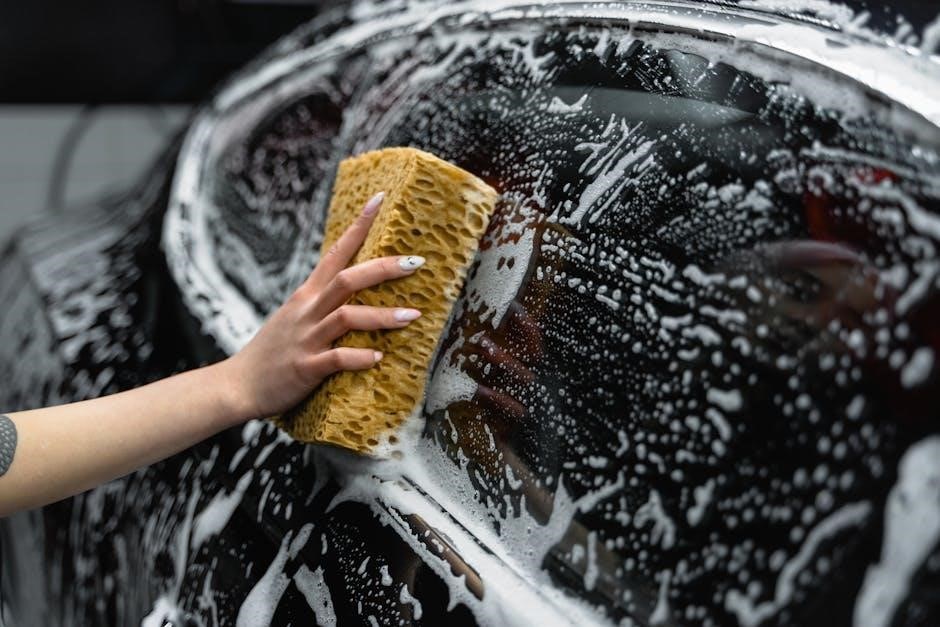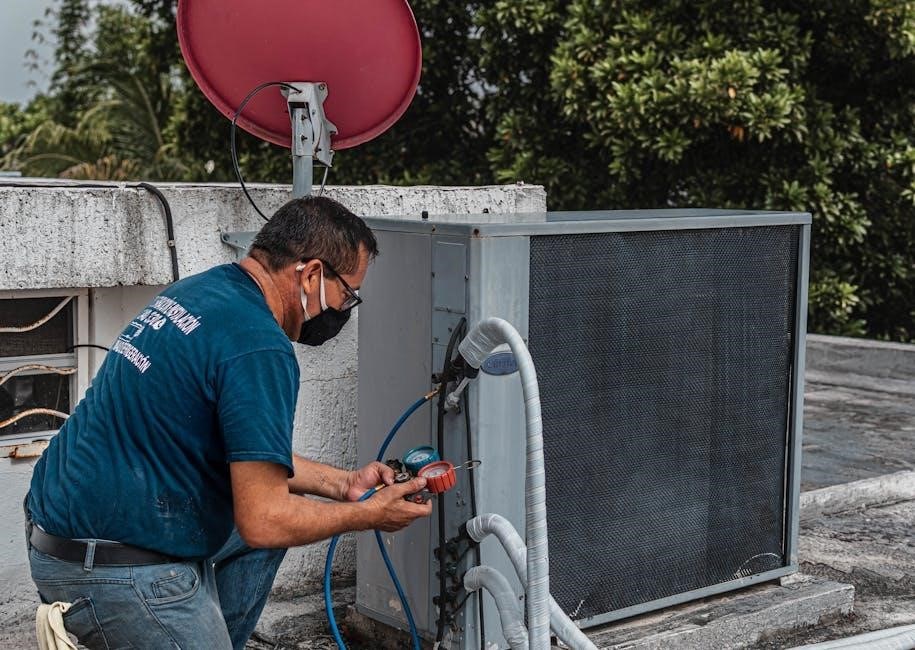
Discover how to effectively troubleshoot your GE window air conditioner with this comprehensive guide. Learn to identify common issues, perform DIY repairs, and maintain optimal performance efficiently.
Understanding the Importance of Regular Maintenance
Regular maintenance is crucial for ensuring your GE window air conditioner operates efficiently and effectively. By cleaning the air filter, inspecting drainage systems, and lubricating moving parts, you can prevent common issues like frozen coils and water leakage. Proper upkeep also improves energy efficiency, reducing operational costs. Neglecting maintenance can lead to breakdowns, higher utility bills, and premature wear of components. Simple tasks, such as ensuring proper ventilation and checking for blockages, can significantly extend the unit’s lifespan. A well-maintained air conditioner not only performs better but also provides consistent cooling comfort. Stay proactive with routine checks to avoid unexpected malfunctions and keep your unit running smoothly throughout the season.
Overview of Common Issues and Solutions
GE window air conditioners are reliable, but they can experience issues like power failures, frozen coils, or water leakage. Common problems often stem from poor maintenance or installation errors. Solutions include resetting the unit, cleaning filters, and inspecting drainage systems. Addressing these issues early can prevent costly repairs. For example, a malfunctioning thermostat or sensor may cause temperature fluctuations, which can be resolved by checking wiring or replacing faulty parts. Regular maintenance, such as cleaning filters and ensuring proper ventilation, can significantly reduce the likelihood of these problems. By understanding the root causes and applying simple fixes, you can restore your air conditioner to optimal performance and enjoy consistent cooling comfort throughout the season.

Common Issues with GE Window Air Conditioners
GE window air conditioners may face issues like power supply problems, frozen coils, strange noises, water leakage, temperature fluctuations, and faulty thermostats. Addressing these promptly is key.

Air Conditioner Won’t Turn On
If your GE window air conditioner won’t turn on, it could be due to power supply issues, a faulty compressor, or a malfunctioning control board. First, ensure the unit is properly plugged in and check the circuit breaker or fuse box. Verify that the thermostat is set correctly and the remote control has fresh batteries. If the issue persists, try resetting the air conditioner by unplugging it for 2-3 minutes. If it still doesn’t turn on, inspect the power cord for damage or consult the user manual for troubleshooting steps. In severe cases, contact a professional to diagnose and repair internal components like the compressor or control board.
Issues with Power Supply
Power supply issues are common and can prevent your GE window air conditioner from functioning properly. Ensure the unit is plugged into a working outlet and that the power cord is undamaged. Check the circuit breaker or fuse box to confirm the circuit hasn’t tripped or blown. Verify that the voltage supply matches the unit’s requirements, as specified in the user manual. If the air conditioner is installed incorrectly, it may overload the circuit. Consult the manual for installation guidelines and troubleshooting steps. Persistent power issues could indicate a faulty electrical component, requiring professional assistance to repair or replace damaged parts. Always prioritize safety when addressing electrical concerns to avoid further complications or hazards.
Frozen Coils and Ice Buildup
Frozen coils and ice buildup are common issues that can significantly reduce your GE window air conditioner’s efficiency. These problems often occur due to low refrigerant levels, restricted airflow, or improper drainage. To address this, turn off the unit and allow it to thaw completely. Check the air filter and ensure it is clean to maintain proper airflow. Verify that the drain is clear to prevent water accumulation, which can contribute to ice formation. If the issue persists, inspect the refrigerant levels and ensure the condenser coils are clean. Regular maintenance, such as cleaning the filter and inspecting drainage systems, can help prevent frozen coils and maintain optimal performance. Always refer to your user manual for specific guidance.
Strange Noises During Operation
Strange noises during operation can be alarming but are often diagnosable. Common sounds include rattling, clunking, or hissing. Rattling may indicate loose parts or debris inside the unit, while clunking could signal a faulty fan or motor. Hissing sounds often point to a refrigerant leak. To address this, turn off the unit and inspect for loose screws or foreign objects. Check the fan for obstructions and ensure all internal components are secure. If the noise persists, it may indicate a more serious issue, such as a malfunctioning compressor or motor. Refer to your GE window air conditioner manual for troubleshooting steps or contact a professional if the problem remains unresolved.
Water Leakage Problems
Water leakage from your GE window air conditioner can be a sign of improper installation or drainage issues. Ensure the unit is installed level and securely to prevent water from spilling over. Check the drain system for blockages, as debris or dirt can clog the drainage path. Regularly clean the condenser coils, as dirt buildup can reduce efficiency and cause excess moisture. If the issue persists, inspect the drain pan for cracks or damage. Refer to your GE window air conditioner manual for specific drainage solutions or consider installing a drain kit to direct water safely. Proper maintenance can prevent leakage and ensure efficient operation.
Temperature Fluctuations
Temperature fluctuations in your GE window air conditioner can be caused by faulty sensors, a malfunctioning thermostat, or clogged air filters. Ensure the thermostat is working correctly and adjust settings if necessary. Clean or replace the air filter to improve airflow and maintain consistent cooling. Check for proper insulation around the unit to prevent heat loss. If the issue persists, inspect the temperature sensor for damage or misalignment. Refer to your GE manual for recalibration instructions or consider replacing the sensor. Addressing these issues can stabilize the temperature and restore optimal performance. Regular maintenance and inspections can prevent such fluctuations from occurring.
Faulty Thermostat or Sensors
A faulty thermostat or sensor in your GE window air conditioner can disrupt temperature regulation, leading to inconsistent cooling or heating. If the thermostat is unresponsive or inaccurate, check its alignment and ensure it’s clean. Sensors may malfunction due to dirt or misalignment, causing the unit to misread room conditions. Refer to your GE manual for error codes related to sensor issues. If troubleshooting steps fail, the sensor or thermostat may need replacement. In some cases, recalibrating the thermostat or sensor can resolve the issue. Addressing these problems promptly ensures optimal performance and prevents further complications. Always consult a professional if internal components are damaged or beyond DIY repair.


Advanced Troubleshooting Steps
Explore advanced methods to diagnose and repair complex issues in your GE window AC, such as resetting the unit, checking error codes, and inspecting internal components.

Resetting the Air Conditioner
Resetting your GE window air conditioner is a simple process that often resolves minor glitches. Start by unplugging the unit from the power source for 2-3 minutes to allow the internal components to reset. After this period, plug the air conditioner back in and turn it on to test if the issue has been resolved. If the problem persists, ensure the unit is properly installed and grounded. Resetting can address issues like unresponsive controls or error codes. However, if the problem recurs, further troubleshooting or professional assistance may be required to identify and fix the root cause.
Checking and Replacing the Filter
Regularly checking and replacing the air filter in your GE window air conditioner is crucial for maintaining efficient operation. Locate the filter, typically found in the front or bottom of the unit. Turn off the air conditioner and remove the filter. Clean it gently with a vacuum or soft brush, or replace it if damaged. A dirty or clogged filter can reduce airflow, increase energy bills, and cause the unit to overheat. Replace the filter every 30 days or as recommended in your manual. Proper filter maintenance ensures optimal cooling performance and prevents potential issues like frozen coils or reduced efficiency;

Diagnosing Error Codes
GE window air conditioners often display error codes to indicate specific issues. To diagnose these codes, start by turning off the unit and checking the display for the code. Refer to your user manual, as it provides a list of error codes and their meanings. Common codes like E14 may indicate sensor or control board issues. If you encounter an error, try resetting the air conditioner by unplugging it for 30 seconds. If the issue persists, consult the troubleshooting section in the manual or contact GE customer support. Accurate diagnosis of error codes ensures timely repairs and prevents further damage to your unit. This process helps you address problems effectively and maintain your air conditioner’s performance.

Inspecting the Condenser Coils
Inspecting the condenser coils is a critical step in troubleshooting your GE window air conditioner. Dirty or clogged coils can significantly reduce efficiency and cause operational issues. Begin by turning off the unit and unplugging it for safety. Remove the grille or casing to access the coils. Use a soft brush or vacuum cleaner to gently remove dirt, dust, or debris. Check for bent fins and straighten them using a fin comb if necessary. Ensure no objects are blocking airflow around the coils. Clean condenser coils improve cooling performance and prevent overheating. Regular maintenance helps extend the lifespan of your air conditioner and ensures optimal operation. Always refer to your manual for specific guidance on accessing and cleaning the coils safely.
Verifying Proper Installation
Verifying proper installation is essential for ensuring your GE window air conditioner operates efficiently. Start by checking that the unit is securely mounted in the window, using the provided installation kit. Ensure the window frame is level and the air conditioner is aligned correctly to avoid tilting. Proper sealing around the unit is crucial to prevent air leaks and moisture issues. Verify that the drain system is correctly positioned to allow water to exit without pooling. Also, check that the electrical connections are secure and meet local safety standards. If any installation issues are found, consult the user manual or contact a professional for adjustments. Correct installation ensures optimal performance, energy efficiency, and prevents future operational problems. Regularly inspect the installation to maintain proper function and safety.

Maintenance Tips to Prevent Future Issues
Regular maintenance is key to preventing issues with your GE window air conditioner. Clean the air filter monthly, inspect drainage systems for blockages, and lubricate moving parts. Ensure proper ventilation by sealing gaps around the unit and keeping the condenser coils clean. Schedule annual professional inspections to identify potential problems early. By following these steps, you can extend the lifespan of your air conditioner, improve efficiency, and avoid costly repairs. Consistent upkeep ensures optimal performance and keeps your space cool and comfortable year-round.
Cleaning the Air Filter
Regularly cleaning the air filter is essential for maintaining your GE window air conditioner’s performance. A dirty filter can reduce airflow, decrease efficiency, and increase energy bills. To clean the filter, turn off the unit, remove the filter, and vacuum it with a soft brush. For deeper cleaning, wash it with mild soap and warm water, then let it dry completely before reinstalling. Replace the filter if it’s damaged or excessively dirty. Cleaning the filter every 1-2 months ensures optimal airflow, improves air quality, and prevents premature wear on the unit. This simple maintenance step can significantly extend the lifespan of your air conditioner and keep it running efficiently.
Inspecting Drainage Systems
Regular inspection of your GE window air conditioner’s drainage system is crucial to prevent water leakage and ensure proper operation. Check the drain pan and hoses for blockages, such as dirt or mold, which can cause water to accumulate. Ensure the unit is installed with a slight backward tilt to facilitate proper water drainage. If you notice water pooling or leakage, inspect the drain hose for kinks or damage and straighten or replace it as needed. Clean the drain pan periodically to avoid mold growth. Proper drainage maintenance prevents water damage, reduces humidity, and enhances overall cooling efficiency. Addressing drainage issues promptly avoids costly repairs and ensures your unit runs smoothly.
Lubricating Moving Parts
Lubricating the moving parts of your GE window air conditioner is essential to ensure smooth operation and prevent premature wear. Regularly inspect the fan motor, compressor, and other mechanical components for proper lubrication. Use a high-quality silicone-based spray lubricant suitable for HVAC systems. Avoid using petroleum-based products, as they can degrade rubber seals and cause damage. Apply a small amount of lubricant to moving parts, such as fan bearings, to reduce friction and noise. Refer to your user manual for specific instructions on which parts require lubrication and how often. Proper lubrication extends the lifespan of your unit, improves efficiency, and reduces the risk of mechanical failure. Always turn off the power before performing any maintenance.
Ensuring Proper Ventilation
Proper ventilation is crucial for the efficient operation of your GE window air conditioner. Ensure the unit is installed with a slight tilt to allow condensation to drain properly. Seal any gaps around the window installation to prevent hot air from entering and cool air from escaping. Keep the area around the air conditioner clear of obstructions to maintain optimal airflow. Regularly inspect the venting system for blockages, such as dust or debris, and clean it as needed. Proper ventilation not only improves cooling efficiency but also helps reduce humidity and prevents mold growth. Refer to your user manual for specific ventilation recommendations tailored to your model.

When to Call a Professional
Contact a licensed technician for complex issues like faulty compressors, serious electrical problems, or error codes that require specialized tools and expertise beyond DIY solutions.
Identifying Serious Electrical Problems
Identify serious electrical issues by checking for blown fuses, tripped circuit breakers, or exposed wiring. If the air conditioner repeatedly trips the circuit or shows signs of electrical damage, such as burning smells or sparks, immediate professional intervention is necessary. DIY repairs can be dangerous and may lead to further damage or safety hazards. A licensed electrician or HVAC technician should handle wiring repairs, faulty circuit connections, or compressor-related electrical faults. Never attempt to fix internal electrical components yourself, as this can void the warranty or cause severe safety risks. Professional diagnosis ensures proper repairs and prevents potential fire hazards or electrical shocks.
Dealing with Faulty Compressors
A faulty compressor is a serious issue that requires immediate attention, as it is the heart of your GE window air conditioner’s cooling system. If the compressor fails, the unit will not cool properly, and you may notice unusual noises or complete shutdowns. DIY repairs are not recommended due to the complexity and potential dangers of handling high-pressure refrigerants and electrical components. If you suspect compressor failure, consult a professional HVAC technician who can assess and replace the compressor if necessary. Ignoring this issue can lead to further damage or complete system failure, making timely intervention crucial for restoring functionality and preventing costly replacements.
Addressing Complex Error Codes
Complex error codes on your GE window air conditioner indicate specific issues that require professional attention. For example, an E14 error code may signal a malfunction in the unit’s sensors or internal components. While resetting the air conditioner or cleaning the filter can sometimes resolve minor issues, advanced error codes often point to deeper problems that cannot be fixed with basic troubleshooting. Always refer to your user manual to understand the meaning of specific codes, but avoid attempting DIY repairs for critical faults. Contact a certified HVAC technician to diagnose and repair internal components like control boards or sensors to ensure safe and effective resolution. Timely professional intervention is essential to prevent further damage and restore proper functionality.